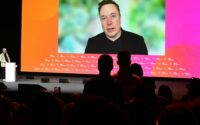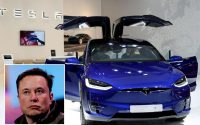GM, BMW, Honda, Mercedes to launch EV charging network in challenge to Tesla
Seven major automakers say they’re joining forces to build a North American electric vehicle charging network that would rival Tesla’s and nearly double the number of fast-charging plugs in the US and Canada.
General Motors, BMW, Honda, Hyundai, Kia, Mercedes and Stellantis said Wednesday that they will share in a multi-billion dollar investment to build “high power” charging stations with 30,000 plugs in urban areas and along travel corridors.
The dramatic move is intended to speed the adoption of electric vehicles, allaying fears that chargers won’t be available for long distance travel.
The companies wouldn’t disclose the exact number of charging stations or financial details of the joint venture they’re forming to put the network in place.
While they said the first of the U.S. chargers will be ready by next summer, they also would not say how long it will take to build the entire network.

The automakers said in a joint statement Wednesday that they want to build the “leading network” of reliable high-powered charging stations in North America.
“The parties have agreed not to disclose specific investment numbers at this time, but the seven founding automakers intend to work as equals to ensure the success of the joint venture,” the companies said in a written statement answering questions from The Associated Press. “As you can imagine, such a high-powered charging network of this scale requires a multibillion dollar investment.”
There are currently just under 8,700 direct-current fast-charging stations in the US and Canada with nearly 36,000 charging plugs, according to the Department of Energy.
Fast chargers can get a battery to 80% of its capacity in 20 minutes to one hour, making them optimal for travel corridors and in some cases comparable to a gasoline fill-up.
They’re much quicker than 240-volt “Level 2” chargers that can take hours to get a battery to a full charge.
The new network is expected to have 10 to 20 charging plugs per station, meaning there would be a minimum of 1,500 stations and a maximum of about 3,000.

Tesla’s network, with the largest number of fast chargers in North America, has 2,050 stations and more than 22,000 plugs in the US and Canada, the DOE says.
The network formed by the seven automakers would be public and open to all electric vehicle owners. It will have connectors for both Tesla’s North American Charging Standard plugs as well as the Combined Charging System plugs used by other automakers.
The network will speed up electric vehicle sales in North America by getting people who now are reading stories about holes in the charging network that prevent long-distance travel, said Stephanie Brinley, an analyst with S&P Global Mobility.

“It’s stopping them even from exploring what EV life is like,” Brinley said. The announcement of the network “is giving them confidence that this is going to work out.”
In their statement, the seven automakers said they would use renewable energy as much as possible to power the chargers, and they will be in convenient locations with canopies and amenities such as restrooms, food service and stores nearby.
Brinley said a good charging experience is key to earning the trust of potential EV buyers. “The reality is consumers want to feel comfortable when they charge,” she said.

It will take years and billions of dollars to build out the network, which will need special electrical wiring, Brinley said.
The automakers will seek to use US government funds from the bipartisan infrastructure law to help pay for the network.
“This joint venture will be a critical step in accelerating EV adoption across the US and Canada, Honda CEO Toshihiro Mibe said in a statement.


